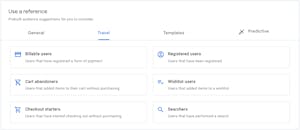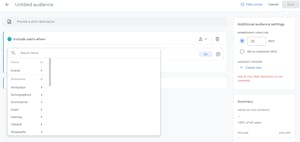- 10 minute read
- SEO
- Websites
Google Analytics: What It Is & Why You Need It (Updated for GA4)
Beginner
Join hundreds of other operators and REGISTER NOW for Spark 2024 New Orleans October 13-15th!

We have covered the details of getting past any mistakes you may make in Google Analytics 4 (GA4) in a previous article you may want to check out.
Now, we want to dive a bit deeper into the details of audience segmentation and using the tools GA4 has available to ensure you can correctly differentiate all your target markets.
That is a fancy way of saying you need to separate your potential customers. Having a solid online presence is essential to today’s marketplace. While you can do everything possible to make your content mobile-ready, engaging, and fun to read, you also need to adjust based on the responses of your market.
A great way to do this is to create custom audiences. If you are running a Boston food tour, but your ads are hitting people looking for desert vacations in California, you are not targeting the right people.
Having segments of core demographics, interests, and data-driven audiences will boost your ability to reach the best-fit clients for your activities, tours, and attractions.
 Pro Tip: As you read this article, remember your long-term customers, not just new leads. Try to segment based on what brings in return and referral business as much as any future potential customers.
Pro Tip: As you read this article, remember your long-term customers, not just new leads. Try to segment based on what brings in return and referral business as much as any future potential customers.
Custom audiences in GA4 are user segments based on specific criteria you define. By grouping users with similar characteristics or behaviors, you can gain valuable insights and make informed decisions about your marketing strategies. You are looking for existing, new, and complementary clients according to what they love about your niche market.
In GA4, two audiences are automatically generated for your benefit:
You can break down these two categories into more detailed segments based on when they made a purchase, or demographics. GA4 offers a list of prebuilt suggested audiences that will help guide your decision-making, so if you are new to this data analytics experience or want to avoid hiring a pro to help, you can still navigate the system.
So, why go through this process to begin with? Having a target audience from which you can cultivate feedback informs your future decision-making. You can determine the success of different marketing campaigns to boost your ROI. Or, track users as they journey through your app and website so you can improve their experience and customer service.
The end goal is that you can identify the best channels for bringing in more clients and increasing brand loyalty. If you discover that Pinterest ads driving traffic to your mom-and-pop Colorado River tour are bringing in the most activity, maybe you slow your ad spend on Google for local results. You need this info to make better decisions and streamline your business.

In addition to the default audiences, GA4 also provides a list of prebuilt suggested audiences. These suggested audiences cover various user segments and can be adjusted to fit your specific requirements.
For example, someone running a pirate-themed mini-golf course in Florida can narrow down the parameters in the “Purchasers” audience to identify families and segments who have purchased a particular tour or activity before. By doing so, the golf course and ad campaigns can be adjusted to ensure a consistent flow of activity via practical marketing efforts.
This innovative analytics tool is fantastic for improving your website. You can use GA4’s suggested audiences to see what people are looking at on your site, and which activities and information they favor, and then tweak your site to feature that content. You essentially give your audience more of what they love – growing your online reputation and building brand loyalty.
Many times, the automatic audiences are not going to fit your particular needs.
Your goal is to create an audience based on the characteristics of the clients you want the most. This may be looking for an age group you know loves your wine tour in Northern California or sticking to interests of people from major cities for your New Orleans ghost tour.
The same concept also applies to return buyers. You can create a parameter about clients that have made multiple purchases in the past to figure out how best to deliver higher lifetime value and grow your return business.
Crafting a custom audience may seem challenging for people without previous experience, but don’t worry; the user interface is easier to follow than you imagine.
Once you land on your dashboard, you can click on Configure and then Audiences. There, you’ll find the two automatically generated audiences as well as an option to “create a custom audience.” Google does a great job covering all the details of this process.
 Pro Tip: It helps to know the difference between sessions and events in GA4. You’ll get this as you go, but a session generally starts when someone opens your app or website. A session includes several events. These could be viewing a specific page, completing an action, etc. Knowing the difference will help you create better-customized audiences.
Pro Tip: It helps to know the difference between sessions and events in GA4. You’ll get this as you go, but a session generally starts when someone opens your app or website. A session includes several events. These could be viewing a specific page, completing an action, etc. Knowing the difference will help you create better-customized audiences.

Okay, so you’ve gone through GA4, learned how to set up custom audiences, and are ready to maximize the info you get from the online tool. Fantastic! Now, where do you as a tour, activity, or attraction business begin?
Start locally! Create custom audiences that relate to your geographic area. You want to serve your local community first and then expand.
For example, if most of your traffic is from schools and families with young children living within a 50-mile radius of your attraction, you’d need to set up a custom audience based on local marketing and SEO.
Another great example is age groups and return visits. Say you have a garden tour website. You will want to set up an age group of 35-75-year-old visitors that return to your website every 30 days (known as membership duration). This way, you are crafting an audience of your most loyal patrons likely to return to your tour as the flowers, veggies, and fruits bloom.
You can learn more from Google about how to customize your target audience in GA4. We especially like setting up segments of users that spend a certain amount. That gives you tremendous insight into the characteristics of your most likely purchases for generating high cash flow. This custom audience can provide valuable insights into your high-value customers and inform strategies to encourage repeat bookings, upsells, or targeted loyalty programs.
When you are developing customized audiences in GA4, the vital thing to remember is that there is no “magic formula.” It is going to be a trial-and-error process. Even the highest-paid professionals will use A/B testing and other marketing techniques to determine how to effectively interpret the data you receive.
Give yourself the freedom to try new things, have fun, and think outside the box. With custom audiences, you can create more personalized customer experiences, build stronger relationships, and ultimately achieve more significant business growth.